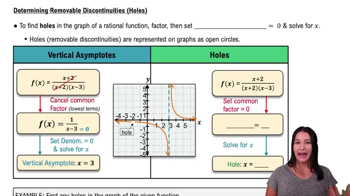Table of contents
- 0. Review of Algebra4h 16m
- 1. Equations & Inequalities3h 18m
- 2. Graphs of Equations43m
- 3. Functions2h 17m
- 4. Polynomial Functions1h 44m
- 5. Rational Functions1h 23m
- 6. Exponential & Logarithmic Functions2h 28m
- 7. Systems of Equations & Matrices4h 6m
- 8. Conic Sections2h 23m
- 9. Sequences, Series, & Induction1h 19m
- 10. Combinatorics & Probability1h 45m
5. Rational Functions
Asymptotes
Problem 29a
Textbook Question
Match the rational function in Column I with the appropriate descrip-tion in Column II. Choices in Column II can be used only once. ƒ(x)=(x+7)/(x+1)
 Verified step by step guidance
Verified step by step guidance1
Identify the rational function given: \( f(x) = \frac{x+7}{x+1} \).
Determine the vertical asymptote by setting the denominator equal to zero: \( x+1=0 \). Solve for \( x \).
Find the horizontal asymptote by comparing the degrees of the numerator and the denominator. Since both are degree 1, the horizontal asymptote is \( y = \frac{1}{1} = 1 \).
Check for any holes in the graph by seeing if there are common factors in the numerator and denominator. In this case, there are none.
Analyze the end behavior of the function by considering the horizontal asymptote and the behavior as \( x \to \infty \) and \( x \to -\infty \).
Recommended similar problem, with video answer:
 Verified Solution
Verified SolutionThis video solution was recommended by our tutors as helpful for the problem above
Video duration:
1mPlay a video:
Was this helpful?
Key Concepts
Here are the essential concepts you must grasp in order to answer the question correctly.
Rational Functions
A rational function is a function that can be expressed as the ratio of two polynomials. In the given function ƒ(x)=(x+7)/(x+1), the numerator is a polynomial of degree one, and the denominator is also a polynomial of degree one. Understanding the structure of rational functions is essential for analyzing their behavior, including asymptotes and intercepts.
Recommended video:

Intro to Rational Functions
Vertical Asymptotes
Vertical asymptotes occur in rational functions where the denominator equals zero, leading to undefined values. For the function ƒ(x)=(x+7)/(x+1), setting the denominator x+1 to zero reveals a vertical asymptote at x=-1. This concept is crucial for understanding the limits and behavior of the function near these points.
Recommended video:

Determining Vertical Asymptotes
Horizontal Asymptotes
Horizontal asymptotes describe the behavior of a rational function as x approaches infinity or negative infinity. For the function ƒ(x)=(x+7)/(x+1), the degrees of the numerator and denominator are the same, indicating a horizontal asymptote at y=1, which is found by taking the ratio of the leading coefficients. This concept helps in predicting the long-term behavior of the function.
Recommended video:

Determining Horizontal Asymptotes

 6:24m
6:24mWatch next
Master Introduction to Asymptotes with a bite sized video explanation from Callie
Start learningRelated Videos
Related Practice







